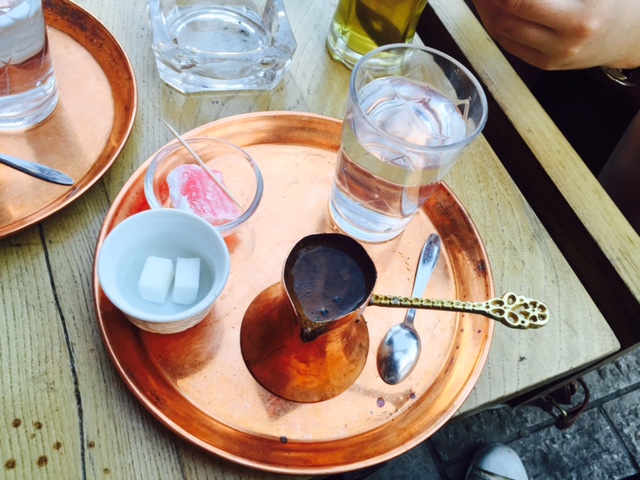
By Dianne Kaiyoorawongs
“Do you think I am supposed to drink the stuff at the bottom? Maybe it’s sugar,” I asked Olivia, sitting next to me, as I swirled a mass of muddy coffee grounds in the bottom of my espresso cup.
I had ordered coffee but little did I know that what I would receive would be far from the standard, filtered espresso on a ceramic plate with a packet of sugar. The server brought out a sizable copper plate with a long handled pot filled with “džezva,” or frothy coffee, an espresso cup with two cubes of sugar, a glass of water, and a small dish of Turkish delight. I thought I knew what I was doing.
I poured the coffee over the two sugar cubes and took a sip. It was sickeningly sweet. I gulped down my water and added more coffee to the cup. Sip. Not bad. I had once seen people drink Turkish coffee from similar copper instruments at Istanbul Café in New Haven and was amused that Bosnian coffee had been so influenced by four centuries of Ottoman rule.
That is why, when I was finally able to speak to a local about Bosnian coffee, I was surprised to hear that it was actually a little different from its Turkish counterpart. “So how is Bosnian coffee made?” I asked Mossad, our server. “I show you,” he responded, motioning me to come into the kitchen. As he demonstrated, Bosnian coffee is made from adding finely ground coffee to hot water and further boiling it until it foams. The foam is a point of Bosnian pride, since Turkish coffee is often added to cold water and later heated, so it never foams.
Drinking Bosnian coffee is a bit of a process as well, as I learned after my first coffee in Bosnia, where I horribly botched the pouring process, took in a mouth full of coffee grounds I mistook for sugar, and burned my tongue. Here is how to do it properly:
Step 1: Spoon out a small amount of foam.
Step 2: Pour some coffee from the džezva into your cup.
Step 3: Add the foam back in, so that you get foam with each cup.
Step 4: You can use the spoon while pouring to ensure that you don’t get any grounds from the džezva in your cup, as well.
Step 5: If you would like sugar with your coffee, take a small bite from the cube and hold it under your tongue. It will melt as you sip your coffee, and you will be able to taste the amalgamation of flavors as it occurs in your mouth.
Step 6: Sip your water as you drink your coffee, so that each mouthful is a new experience.
Step 7: Lean back, people watch, and enjoy your time in Bosnia.
Dianne Kaiyoorawongs ’17 is a junior in Ezra Stiles College. Contact her at dianne.kaiyoorawongs@yale.edu.